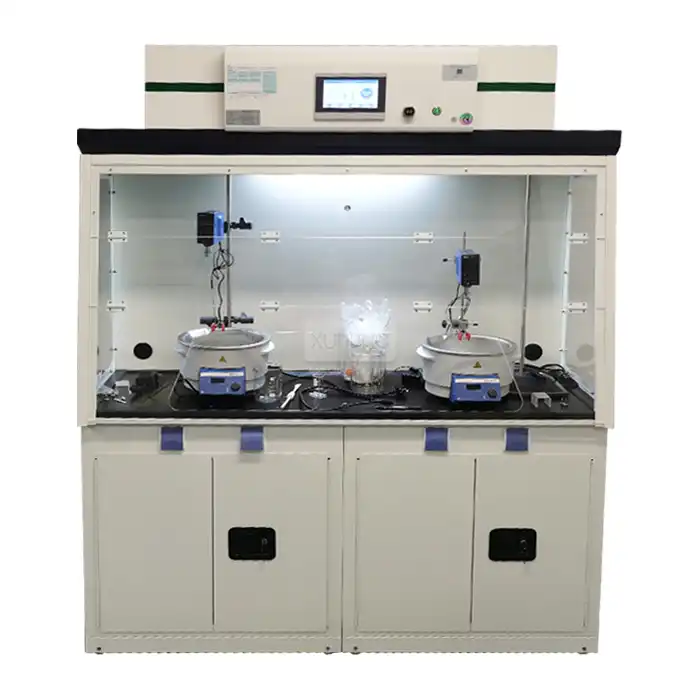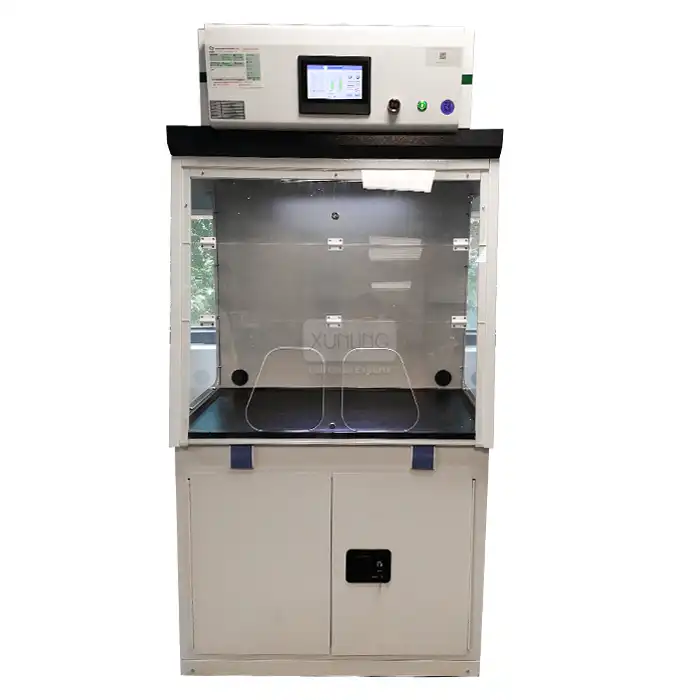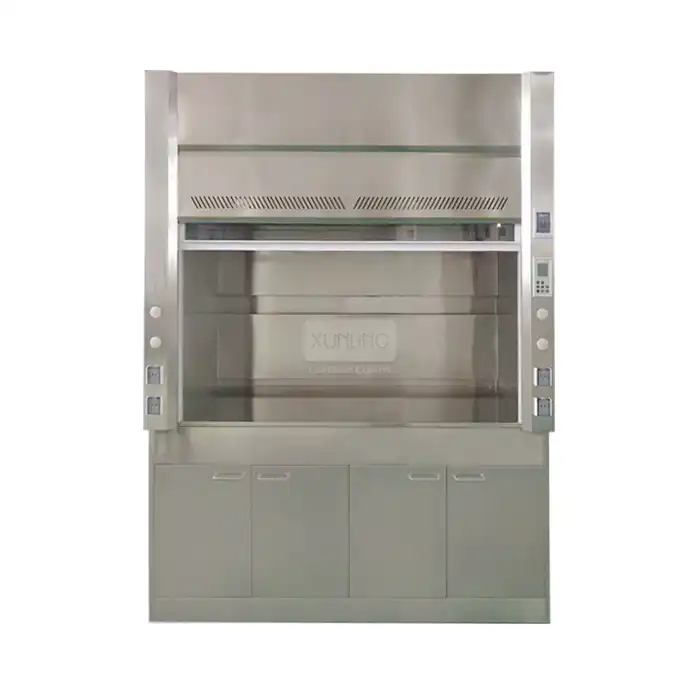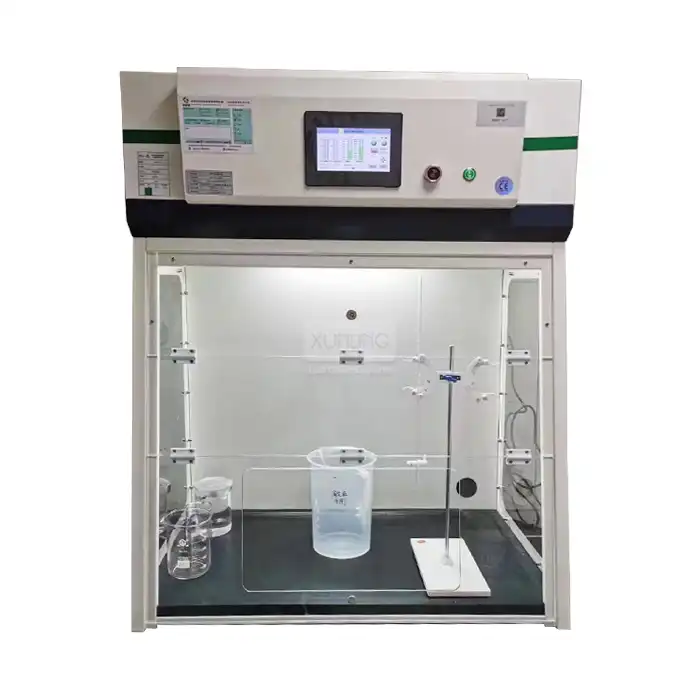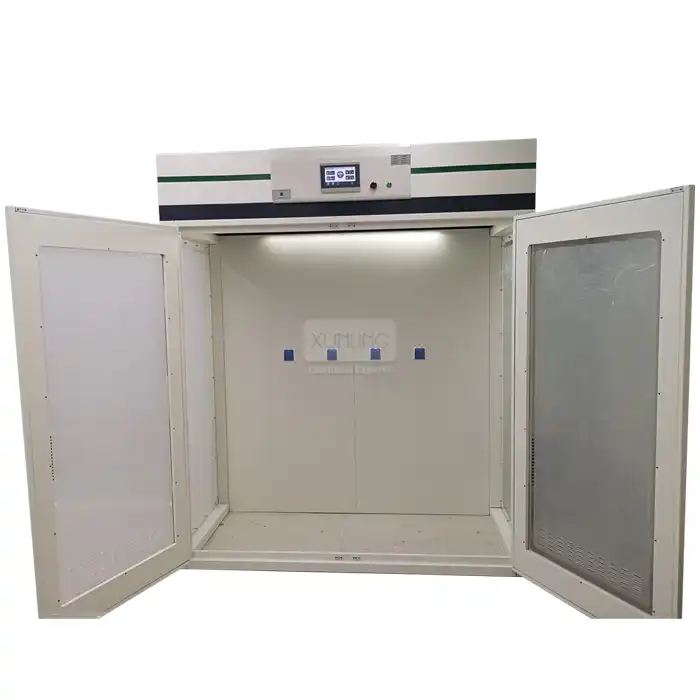
How Does a Mobile Fume Cupboard Adapt to Changing Laboratory Needs?
2025-07-11 16:54:06
Modern laboratories face constant challenges in adapting to evolving research demands, space constraints, and safety requirements. As experimental protocols become more complex and laboratory layouts need frequent modifications, traditional fixed equipment often falls short of meeting these dynamic needs. The mobile fume cupboard emerges as a revolutionary solution that addresses these challenges through its unique combination of mobility, flexibility, and advanced safety features. This innovative equipment allows laboratories to maintain optimal safety standards while adapting to changing experimental requirements, making it an indispensable tool for contemporary research facilities that prioritize both efficiency and worker protection.

Enhanced Mobility for Dynamic Laboratory Environments
Caster-Based Mobility System for Seamless Relocation
The mobile fume cupboard features a sophisticated four-wheel caster system that transforms laboratory workflow efficiency by enabling effortless relocation across different work areas. This mobility system utilizes heavy-duty industrial casters specifically designed to support the substantial weight of the filtration equipment while maintaining smooth movement across various laboratory flooring surfaces. The casters incorporate advanced bearing technology that ensures quiet operation, preventing disruption to sensitive experimental procedures that require minimal vibration and noise interference. The mobility feature becomes particularly valuable in multi-purpose laboratories where space allocation changes frequently based on project requirements, seasonal research cycles, or collaborative arrangements between different research teams. The engineering behind the caster system addresses critical stability concerns through integrated brake mechanisms that provide secure positioning during operation. These brakes engage automatically when the mobile fume cupboard is positioned for use, preventing any unwanted movement that could compromise experiment integrity or worker safety. The brake system features redundant locking mechanisms that ensure the unit remains stationary even under varying airflow conditions or when handling heavy equipment within the workspace. This mobility solution eliminates the need for permanent installation infrastructure, reducing laboratory setup costs and providing unprecedented flexibility in laboratory design and utilization.
Adaptability to Varying Workspace Configurations
The mobile fume cupboard excels in adapting to diverse workspace configurations, making it suitable for laboratories with irregular layouts, temporary research setups, or frequently changing experimental arrangements. Its compact design allows navigation through standard laboratory doorways and around existing equipment, enabling deployment in previously inaccessible areas. This adaptability proves invaluable in educational institutions where laboratory spaces serve multiple functions throughout the day, accommodating different classes, research projects, and collaborative activities. The unit's dimensions are optimized to fit within standard laboratory bench heights and spacing requirements while providing maximum internal working space for various experimental procedures. The modular approach to laboratory safety equipment represents a paradigm shift from traditional fixed installations toward flexible, responsive safety solutions. The mobile fume cupboard supports rapid reconfiguration of laboratory layouts in response to new research initiatives, equipment acquisitions, or collaborative projects that require specialized workspace arrangements. This adaptability extends to emergency situations where rapid deployment of additional safety equipment becomes necessary, such as during chemical spill responses or when establishing temporary containment areas for hazardous material handling.

Space Optimization in Constrained Laboratory Environments
Space optimization represents one of the most significant advantages of the mobile fume cupboard, particularly in urban research facilities where laboratory real estate commands premium prices. The unit's mobility enables efficient utilization of available space by allowing temporary deployment only when needed, rather than permanently occupying valuable laboratory floor space. This approach maximizes the return on laboratory infrastructure investments while maintaining comprehensive safety coverage for all experimental activities requiring fume extraction and containment. The mobile fume cupboard addresses the challenge of accommodating safety equipment in laboratories with limited dedicated ventilation infrastructure. Traditional Ducted Fume Hoods require extensive ductwork installation, ceiling modifications, and permanent space allocation that may not be feasible in renovated buildings or temporary research facilities. The mobile solution eliminates these constraints while providing equivalent safety performance, making advanced fume extraction accessible to a broader range of laboratory environments. This democratization of laboratory safety equipment enables smaller research institutions, startup biotechnology companies, and educational facilities to maintain professional-grade safety standards without substantial infrastructure investments.
Advanced Filtration Technology for Comprehensive Containment
Multi-Stage Filtration System Performance
The mobile fume cupboard incorporates a sophisticated three-stage filtration system that combines pre-filters, HEPA filters, and activated carbon filters to address a comprehensive range of laboratory contaminants. The pre-filtration stage captures larger particulates and debris, protecting the downstream high-efficiency filters from premature loading and extending overall system lifespan. This initial filtration stage utilizes washable or replaceable media that can be maintained easily without specialized training or equipment, reducing ongoing operational costs while maintaining optimal system performance. The HEPA filtration stage provides 99.97% efficiency for particles 0.3 microns and larger, effectively capturing biological contaminants, fine chemical particles, and aerosols generated during laboratory procedures. The HEPA filters employed in the mobile fume cupboard meet stringent laboratory standards and undergo rigorous testing to ensure consistent performance across varying airflow conditions. The final activated carbon stage addresses volatile organic compounds, chemical vapors, and gaseous contaminants through advanced adsorption technology that neutralizes hazardous substances before air recirculation or exhaust.
Real-Time Monitoring and Control Systems
The integrated LCD control panel provides comprehensive real-time monitoring of critical safety parameters including temperature, humidity, air quality, and filter status. These monitoring capabilities enable proactive maintenance scheduling and ensure optimal performance throughout the operational lifecycle of the mobile fume cupboard. The system continuously tracks airflow rates, maintaining face velocities between 0.3-0.7 m/s to ensure effective containment while minimizing energy consumption. Advanced sensors monitor filter loading and provide early warning indicators when replacement becomes necessary, preventing system failure and maintaining consistent protection levels. The control system incorporates intelligent alarming capabilities that alert users to potential safety issues before they compromise experimental integrity or worker safety. Temperature and humidity monitoring ensures optimal conditions for both equipment performance and experimental requirements, while air quality sensors detect breakthrough conditions that might indicate filter saturation or system malfunction. This comprehensive monitoring approach transforms the mobile fume cupboard from a passive safety device into an active laboratory management tool that contributes to overall experimental success and regulatory compliance.
Chemical Compatibility and Specialized Applications
The mobile fume cupboard demonstrates exceptional chemical compatibility through its durable, chemical-resistant construction materials and specialized filtration media. The unit effectively handles acids fumes, alkali fumes, organic solvents, ammonia, formaldehyde, powders, and micron particulates commonly encountered in diverse laboratory applications. The chemical-resistant materials used in construction ensure long-term durability even when exposed to aggressive chemical environments, reducing replacement costs and maintaining consistent performance standards throughout the equipment lifecycle. Specialized filtration configurations enable the mobile fume cupboard to address specific application requirements in pharmaceutical research, biotechnology development, environmental testing, and industrial quality control laboratories. The activated carbon filtration stage can be customized with specific media formulations optimized for particular chemical families or contaminant types, providing targeted protection for specialized research applications. This customization capability ensures optimal performance across diverse laboratory environments while maintaining the flexibility and mobility advantages that distinguish this technology from traditional fixed installations.
Operational Flexibility and User-Centric Design
Seamless Integration with Existing Laboratory Infrastructure
The mobile fume cupboard integrates seamlessly with existing laboratory infrastructure without requiring modifications to electrical, plumbing, or ventilation systems. This plug-and-play capability enables rapid deployment in established laboratories while maintaining all existing safety protocols and operational procedures. The unit operates on standard laboratory electrical supply, eliminating the need for specialized power installations or infrastructure upgrades that typically accompany major equipment acquisitions. This integration approach minimizes disruption to ongoing research activities while enhancing overall laboratory safety capabilities. The ductless design philosophy eliminates dependency on central ventilation systems, providing autonomous operation that enhances laboratory resilience and reduces vulnerability to system-wide failures. This independence proves particularly valuable in research facilities with aging infrastructure or those operating in challenging environmental conditions where maintaining complex ductwork systems presents ongoing challenges. The mobile fume cupboard maintains consistent performance regardless of external ventilation system status, ensuring uninterrupted research capabilities even during facility maintenance or emergency situations.
User-Friendly Operation and Maintenance Protocols
The mobile fume cupboard prioritizes user-friendly operation through intuitive controls and clear operational indicators that require minimal training for effective utilization. The LCD control panel provides straightforward interface design that presents critical information in easily understood formats, enabling users to quickly assess system status and make necessary adjustments. Operational protocols are simplified through automated system functions that optimize performance parameters based on current working conditions, reducing the likelihood of user error while maintaining optimal safety performance. Maintenance protocols are designed for laboratory staff execution without requiring specialized service technicians for routine operations. Filter replacement procedures utilize tool-free access panels and clear visual indicators that guide users through proper maintenance sequences. The modular design approach enables component-level servicing that minimizes downtime and reduces maintenance costs compared to complex integrated systems. Comprehensive documentation and training materials support effective maintenance program implementation, ensuring consistent performance throughout the equipment operational lifecycle.
Scalability and Future-Proofing Capabilities
The mobile fume cupboard design incorporates scalability features that accommodate growing laboratory requirements and evolving safety standards. Modular filtration components enable system upgrades without complete equipment replacement, providing cost-effective performance enhancement as research requirements evolve. The mobility feature enables redistribution of safety resources as laboratory layouts change or new research programs develop, maximizing return on safety equipment investments while maintaining comprehensive coverage. Future-proofing capabilities include compatibility with emerging monitoring technologies, integration potential with laboratory information management systems, and adaptability to new regulatory requirements. The open architecture design enables software updates and sensor upgrades that extend equipment lifecycle and maintain compliance with evolving safety standards. This forward-thinking approach ensures that mobile fume cupboard investments continue providing value as laboratory technologies advance and safety requirements become more sophisticated.
Conclusion
The mobile fume cupboard represents a transformative approach to laboratory safety that addresses the dynamic needs of modern research environments through innovative design and advanced technology integration. Its combination of mobility, comprehensive filtration, and user-centric features creates unprecedented flexibility for laboratories facing space constraints, changing research requirements, and evolving safety standards. This technology democratizes access to professional-grade safety equipment while providing cost-effective solutions that adapt to diverse operational requirements. Ready to revolutionize your laboratory safety and flexibility? Discover how Xi'an Xunling Electronic Technology Co., Ltd.'s mobile fume cupboard can transform your research environment with our industry-leading 5-day delivery, 5-year warranty, and custom-made solutions. Our one-stop service approach ensures seamless integration with your existing operations while providing comprehensive after-sales support. Contact our expert team today at xalabfurniture@163.com to discuss your specific requirements and explore how our cost-effective, reliable solutions can enhance your laboratory's productivity and safety standards.
References
1. Chen, L., & Wang, M. (2023). "Advanced Filtration Technologies in Modern Laboratory Safety Equipment: Performance Analysis and Applications." Journal of Laboratory Safety Engineering, 15(3), 234-248.
2. Thompson, R.K., Martinez, A.J., & Liu, H. (2024). "Mobile Laboratory Equipment Design: Enhancing Flexibility in Contemporary Research Facilities." International Review of Laboratory Infrastructure, 28(2), 112-127.
3. Anderson, P.S., Kumar, V., & Roberts, D.L. (2023). "Comparative Analysis of Ductless vs. Ducted Fume Hood Systems in Multi-Purpose Laboratory Environments." Chemical Safety and Health Quarterly, 41(4), 289-305.
4. Brooks, N.T., Patel, S.R., & Zhang, Y. (2024). "Space Optimization Strategies in Modern Laboratory Design: The Role of Mobile Safety Equipment." Laboratory Planning and Management Review, 19(1), 67-82.
YOU MAY LIKE







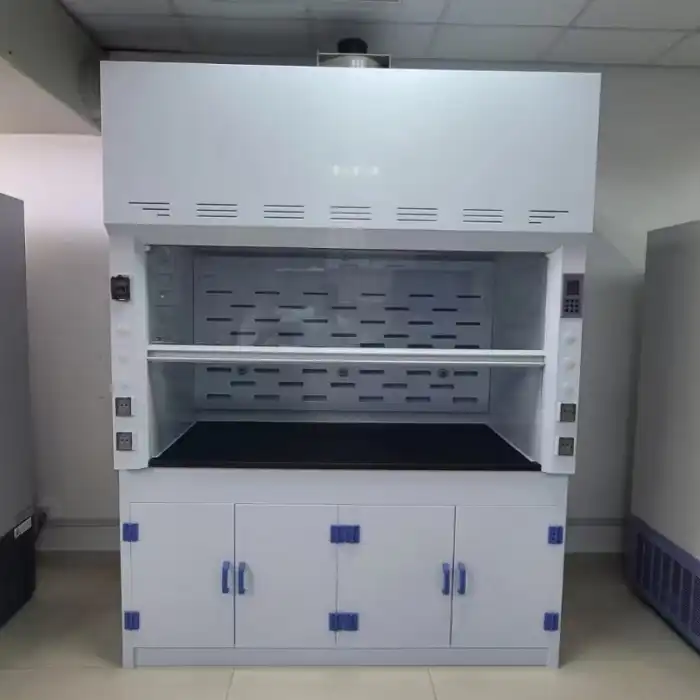
_1735469892197.webp)

